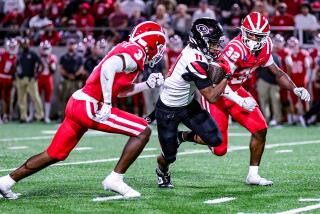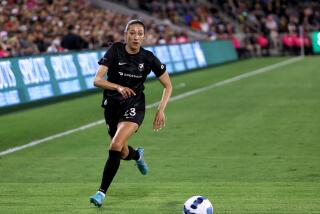Hardy or Foolhardy? : Football Players Often Perform in Pain Despite Risk of Exacerbating Injuries
- Share via
Quarterback Rob O’Byrne lay on the ground after a particularly big knock and glanced down at his right arm, which was feeling a bit nasty. He noticed that the arm made a couple of mountain road-type turns between the elbow and the wrist. And then the pain washed over him.
Both bones in his forearm had been shattered. A few moments later the arm had been immobilized with an inflatable cast and he was led off the field by orthopedic surgeon Richard Ferkel. Later that night, the Crespi High senior would have holes drilled into the bones and large metal pins inserted and fastened to hold the splintered bones together. All of this, of course, is accompanied by pain that would make your hair stand up.
“As we’re taking him off the field,” Ferkel recalled, “he looks at me and asks, ‘Can I play next week?’ That’s how these guys think at first. All they want to do is get back out there.”
O’Byrne, obviously, did not play the next week. His high school career came to an abrupt end and he might never play again, although Ferkel said that with a normal healing process and lengthy rehabilitation program, he might be able to play again next year if any college gives him the chance.
But often, football players--even on the high school or college level--do play within days of suffering a serious injury. Broken bones, severely sprained ankles and wrists, separated shoulders. Even neck injuries don’t stop many players from pulling on their uniform and charging into action again.
In a 10-game season, players do not have time to sit out six weeks for an injury to heal. Players take the field wearing inflatable casts, knee braces or mountains of wrapping tape, anything that will get them through another game.
Playing with pain is just another part of the game.
Sophomore offensive tackle Eric Litmanovich spent the first two weeks of Valley College’s season on crutches but has played since then with a swollen ankle. He strained ligaments in his right ankle during the last week of practice. A cast was recommended but Litmanovich refused it. His hopes of playing for a Division I college are riding on this season. A cast meant missing more games and, he reasoned, that meant no scholarship offers.
“They don’t give scholarships to nice people, you know what I mean,” he said. “I was told that it should have been in a cast but I didn’t want to sit out six weeks.”
Cal Lutheran defensive end Earl Bentancourt knows the feeling. He injured his wrist in the second game of the season. He plans to have it examined and X-rayed and put in a cast, if necessary, after the season. For now, the senior, who leads CLU in sacks and is second in tackles, plays with the wrist taped.
“I can’t pick up my book bag sometimes, I can’t grip it. It might be broken,” he said. “I keep saying I’ll go to the doctor, but I won’t. I’ll let it heal after the season is over.”
Valley fullback Howard Howell played this season with a fractured wrist. Howell sat out a few games when the injury became too painful, but now he’s playing with a flexible cast on his wrist. He exchanges that for a stiffer cast for practice.
“If any other bone was broken, I probably wouldn’t take the risk,” Howell said. “But the way I look at it is that it’s a small bone.”
Division I scouts often rely on game film to evaluate junior college players, and Howell was piling up valuable video time before suffering the injury five weeks into the season. He earned Western State Conference player of the week honors. But now, his chances of playing for a Division I college are jeopardized.
“There’s no telling where I might go now because of the injury,” he said. “I’m sure the injury has had some impact because I haven’t played the whole season.
“The doctor told me that I was taking a risk by playing, but I was willing to take the risk for the win,” he said. “At this point in my career, sitting out wouldn’t help. I really wanted to help out the team.”
Potential scholarships. Helping out the team. Those are two reasons why players go back onto the field with pain. But there are other reasons. Peer pressure is a factor. Staying in the spotlight is another.
Bentancourt is in the healthiest season of his college career. He has suffered severe injuries to both knees, including a 1985 blowout in which all of the ligaments in his right knee were snapped. He underwent three operations on the knee, exhausting his $30,000 insurance policy, then dipped into his own pocket to cover the remaining costs.
But through extensive rehabilitation, he brought the battered knee back to health and returned to the Cal Lutheran team for the 1986 season. And then, before the season started, he completely tore his calf muscle.
“I heard that one,” Bentancourt recalled. “It sounded like someone clapped their hands together. But it just felt like I pulled something, so I walked home. The next morning, though, I couldn’t walk. Then I got kind of worried.”
Cancel Bentancourt’s 1986 season.
Now, Bentancourt must report to trainer Rod Poindexter’s workshop 90 minutes before every practice and game to begin the preparation process. First comes half an hour of muscle-stretching. Then he plops into the whirlpool for another 30 minutes to further loosen his muscles. Then comes Mr. Tape, more than 100 feet of it costing nearly $30. Around each ankle and each wrist and each knee. And then the metal knee braces are fitted. The one protecting his once-decimated right knee is a Lennox Hill model, named after the New York hospital where it was designed 15 years ago for Joe Namath. That brace cost $650.
“Being injured and having to go in an hour-and-a-half before practice just to get ready takes some of the fun out of football,” Bentancourt conceded. “A lot of days I wonder why I’m doing it. Why am I putting my body through this? But I keep coming back to the fact that I just want to play.”
Doctors and trainers who oversee football programs wage a constant battle in determining which players and which injuries can be put back on the field and which ones must stay on the sideline.
The team doctor bears the legal responsibility of fully informing a player and his parents of the potential for further injury. The decision can be influenced by many factors. But the main consideration is whether the injury can be made more severe by further play and contact.
“A lot depends on how we can protect the injury,” said Dr. Lester Cohn, an orthopedic surgeon who has worked with the Cal State Northridge football team for more than two decades. “An acute knee injury is almost impossible to protect. But a broken bone can be like a glass goblet shipped by UPS. You can wrap it and pad it so well that nothing much can happen to it.
“On the college level you weigh the risks. If the risk of re-injury is sufficiently high, we just pull his ticket. We just won’t let him play. The main thing that determines if an injured kid plays is whether the risk is substantial for re-injury or more severe injury. If there is no real risk of either, then he can play if we can protect the injury. If there is a risk, then he’s gone.”
But often, there is conflict. Coaches want their best players on the field. Trainers sometimes incur the wrath of a coach who believes that a player should learn to live with pain.
“As a trainer, you’re going to use everything you’ve got to get them healed faster and back as soon as possible because that’s your job,” said Angelo Cimity, the athletic trainer at Valley.
Said CSUN Coach Bob Burt: “Kids play with little aches and pains all the time. You have to know the difference between pain and injury. There are things that are real painful that you can play with. You learn to play through the pain. A sore arm or a pinched nerve in the neck or even broken bones, depending on which bones, are in that category.”
His starting center, Brian Clark, broke a bone in his hand Oct. 31. He was fitted with a soft, flexible fiberglass cast and played the following week.
“A lot of people play with broken hands,” Burt said. “I guess it’s painful, but they play.”
Yet Burt has his limits.
“My concern is that if a kid isn’t going to get hurt further by playing, then fine, we’ll play him,” he said. “But if there can be further damage, them I won’t let them out there.”
Often, the decision is made by the pain itself.
“We can do all kinds of things to prevent further injury,” CSUN’s Cohn said. “But the bottom line is that a fresh bone fracture hurts, no matter what you do.
“At first, most of them have a ‘Just-tape-it-up-and-let-me-play’ attitude. Football players deal with pain differently than most people. But with some of them, that’s only their first reaction, and only in front of their peers, their teammates. A day or two later, when they’re alone or just with me, kids are kids. If something really hurts, a lot of them want nothing to do with being tackled or crashed into.”
Cimity said he sees the same reaction at Valley.
“They will put undue pressure on themselves to play,” he said. “A lot of the guys who really think they can tough it out show up maybe two or three days after they get hurt and realize they have a problem.”
What doctors and trainers fear most is the code of macho that seems to surround football and often makes an athlete play with a serious injury.
“The guys we’re most concerned with are the tough guys, the macho guys who want to ignore the injury,” Cal Lutheran’s Poindexter. “For those guys, if they can’t play it’s the end of the world. They attach so much importance to it. Our society has done that to these kids. We’ve made our athletes such heroes that we’ve made a game seem like going off to war.
“Not playing would be more painful for them emotionally than the physical pain of playing.”
Barry Daniels, a sophomore at Valley who leads the team in sacks, has come back from strained knee ligaments this season to play. Sitting on the bench hurt more than playing on the gimpy knee, he said.
“When I’m not practicing or working out with the team,” Daniels said, “I feel like a nobody.”
And nobody wants to feel like a nobody.
More to Read
Go beyond the scoreboard
Get the latest on L.A.'s teams in the daily Sports Report newsletter.
You may occasionally receive promotional content from the Los Angeles Times.










